I saw those pics, graham, but it looks like horns were cut in half for packing? But still, poachers do take the stumps,
Saving Private Rhino: We must reimagine the future of species conservation in South Africa
- Richprins
- Committee Member
- Posts: 76086
- Joined: Sat May 19, 2012 3:52 pm
- Location: NELSPRUIT
- Contact:
Re: Saving Private Rhino: We must reimagine the future of species conservation in South Africa
Please check Needs Attention pre-booking: https://africawild-forum.com/viewtopic.php?f=322&t=596
- Lisbeth
- Site Admin
- Posts: 67556
- Joined: Sat May 19, 2012 12:31 pm
- Country: Switzerland
- Location: Lugano
- Contact:
Re: Saving Private Rhino: We must reimagine the future of species conservation in South Africa
Wildlife baron invites investors to lock, stock and barrel sale of his rhino conservation initiative
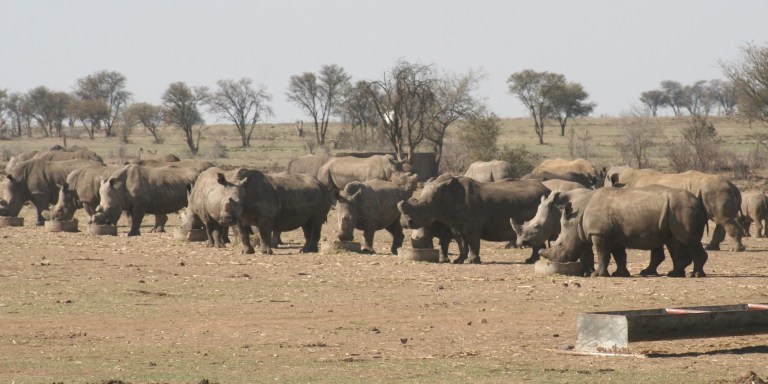
Some of John Hume’s nearly 2,000 strong herd of semi-wild rhinos are fed with supplemental feeds during the dry winter months at his 8,500 hectare ranch in North West. (Photo: Tony Carnie)
By Tony Carnie | 14 Feb 2023
Thirty years after embarking on a speculative – and controversial – wildlife industry venture, the owner of the world’s biggest privately owned herd of rhinos has announced plans to sell up.
___________________________________________________________________________________________________________________________
The South African rhino baron John Hume, now aged 81, issued a media statement this week inviting investors to purchase his “Platinum Rhino breeding and conservation project” (and all 2,000 rhinos) at an online auction to be held in mid-April.
Hume has been cast variously as a “remarkable conservationist” and also as an avaricious speculator who helped to fuel continued global demand for black market rhino horns.
Hume has pushed strongly to overturn the 1977 global ban on rhino horn sales, arguing that there would be no need to kill any rhinos if their horns could be harvested on a regular basis and then sold legally to buyers in the Far East.
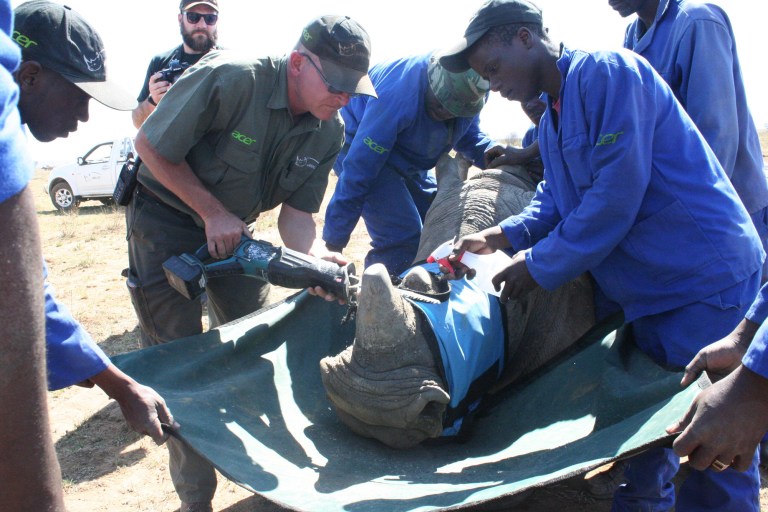
Johnny Hennop removes another horn for stockpiling at John Hume’s ranch in North West. (Photo: Supplied)
But with anti-poaching and breeding costs mounting steadily, Hume appears to have taken a business decision to pack up his rhino breeding business for good, hoping that wealthy investors or philanthropists will see some merit in keeping his venture alive – either for similar commercial reasons or to “rewild” them.
Five years ago, Hume invited investors to take up to a 50% interest in his 8,500 hectare rhino breeding ranch in North West – but there were no takers.
In 2019, he put up a separate property (Mauricedale Game Farm near Kruger National Park) for auction to defray his costs, but not a single buyer came forward when the auctioneer opened the bidding.
His previous attempts to sell a small portion of his massive stockpile of rhino horns in an online auction in 2017 also fell pretty flat, as buyers clearly saw little merit in purchasing horns legally in South Africa when they were prevented from selling them on to buyers in China, Vietnam or elsewhere due to an international ban by the Convention on International Trade in Endangered Species (CITES).
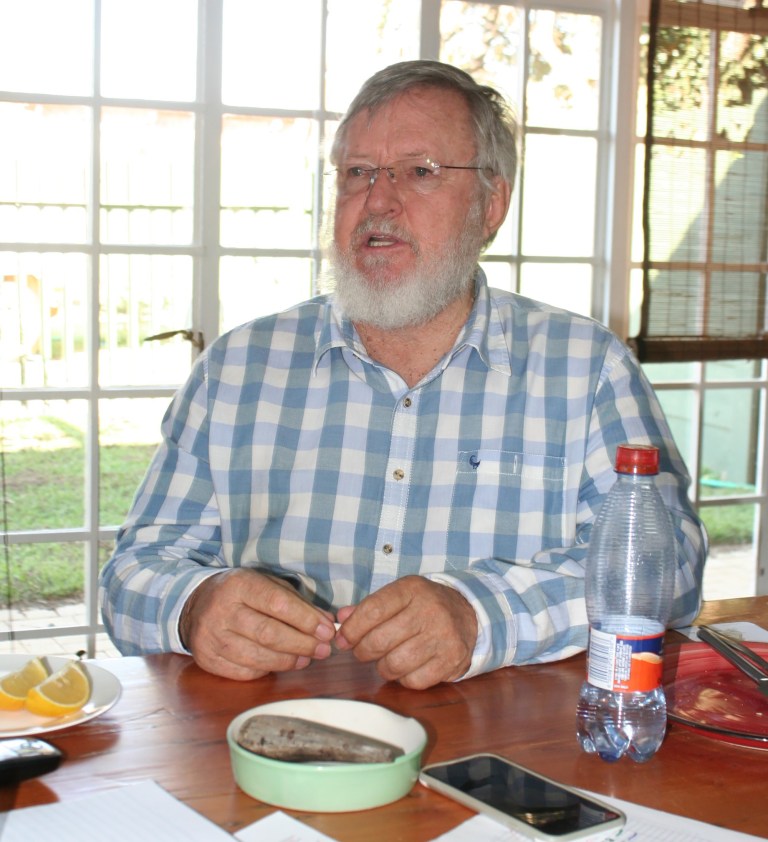
Rhino baron John Hume at his rhino ranch, west of Johannesburg. (Photo: Tony Carnie)
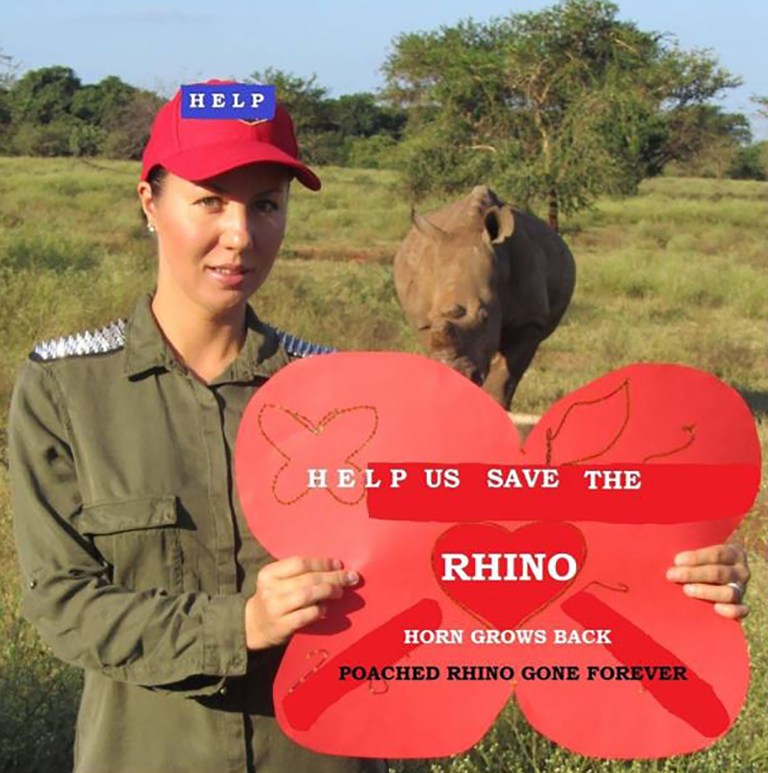
John Hume’s wife Albina pitches her message in a Facebook post. (Photo: Supplied)
Though Hume won a significant court battle in 2015 to overturn a government ban on the domestic sale of rhino horns within South Africa, his more recent forays in the courts have been less successful.
In 2021, Hume sought a court order for the return of nearly R10-million worth of horns which had been seized by the police in an undercover operation by the Hawks during an investigation into black market rhino sales by Hume and other parties.
Two men, Clive John Melville and Petrus Steyn, pleaded guilty and were convicted on charges of engaging in restricted wildlife activities without permits – to wit, possession of 181 white rhino horns that originated from Hume’s secure banking vault in Centurion, Pretoria.
Hume denied any legal wrongdoing in the affair and sued to have the horns returned to him, but Acting Judge SK Hassim found it hard to swallow his story that he had released the horns from his banking vault to a certain Mr Allan Rossouw of Port Elizabeth – a man he had never met – as part of a legal domestic rhino horn transaction.
Counsel for the Hawks and a senior police investigating officer told the court that Rossouw never intended to buy the horns and had merely agreed to have the sale permit registered in his name in exchange for cash.
“This and the other strange features of the transaction between (Hume) and Rossouw,” she argued, “show not only a sham transaction to disguise the illegal sale of the 181 horns, but they show (Hume’s) complicity.
“It was submitted that, in the circumstances, the 181 horns should not be returned to (Hume) before he has explained his involvement and his conduct and that the proper forum for this is not a civil court, but the criminal court,” Hassim declared in a judgment in January 2022.
“(Hume’s) version of events strikes me as most bizarre. It is astounding that a self-professed businessman would voluntarily release valuable assets, such as rhino horns, from his control and custody, entrust them to a ‘potential buyer’ he has never personally met for inspection in the hope that the potential buyer becomes a buyer of the 181 horns at a reasonable price to be agreed. It defies logic why the potential buyer could not inspect the horns at the Centurion vault…
“It is implausible that any person, let alone a self-professed businessman, would release from his control and custody not a few, but all 181 horns, each valued at around R60,000, to a potential buyer without any assurance that the potential buyer intended buying one of them, let alone 181. This scenario borders on the preposterous.”
Hume also lost another civil case in 2020 where he took on national Environment Minister Barbara Creecy, in a case where he was refused permission to sell and export 11 rhinos to a Vietnamese buyer.
Now Hume has averred that he wants to pack up his venture for good and look for a buyer “with a passion for conserving rhinos and the means to keep the breeding project going”.
He argues that his venture has the potential to “save rhinos from extinction”.
“With 200 rhinos born a year, the project has the power to make a significant difference and bolster declining rhino populations on the African continent.
“We have so much rewilding power here,” the project’s wildlife veterinarian, Dr Michelle Otto, said in a statement.
“The project’s rhino could repopulate the whole of Africa, where we lose hundreds of rhinos each year to poaching. We have rewilding partners on board, but the project needs funding and it needs the right person to continue to drive it in the right direction.”
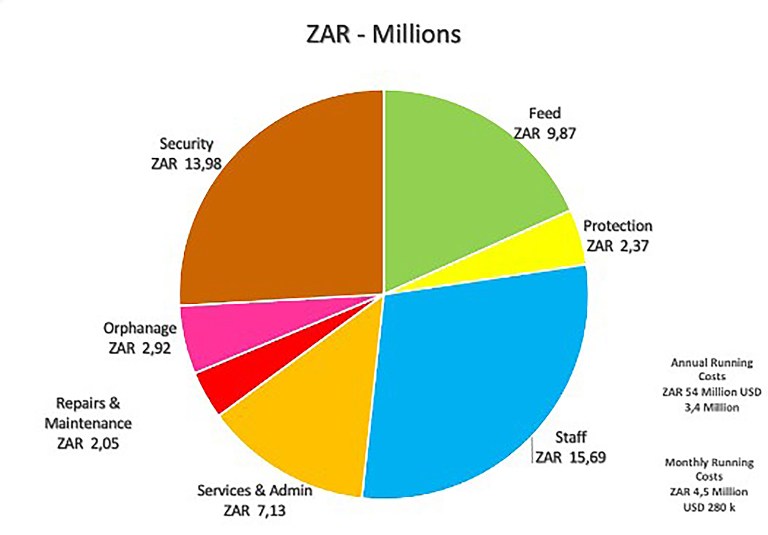
A pie-chart depicting the expenses of running the ranch. (Image: Supplied)
That might seem like a tall claim to make, but in the context of the unrelenting massacre of South Africa’s national rhino herd, it’s worth noting that Hume’s project has preserved at least 2,000 rhinos – just slightly fewer than the remaining population of rhinos in Kruger National Park.
Over the last decade, South Africa has lost close to 10,000 rhinos to poachers – mostly in state or provincial parks.
Dr John Hanks, a zoologist with a PhD from Cambridge on elephant population dynamics and a former director of the Africa Programme for WWF International, has provided a strong endorsement for Hume’s Platinum Rhino venture.
“This is an outstanding contribution to the long-term security of the species, for which (Hume) deserves an enormous vote of thanks and appreciation from the international conservation community. This remarkable success could not have been achieved without an unprecedented level of financial support, all of which has come from John’s life savings.
“Protecting rhinos in today’s world from the increasing attacks by poaching gangs is an extremely expensive operation, as all the government conservation agencies in Africa know only too well.”
Dr George Hughes – a veteran conservationist and former chief executive of the Natal Parks Board/Ezemvelo KZN Wildlife, who favours a legal trade in rhino horn – said this week that Hume’s decision to put his rhino breeding enterprise up for auction was likely to be “a great disappointment to both John and to rhino conservation”.
“I know that John was often criticised. But he should have been awarded a Nobel Prize for rhino conservation, whatever his motives. He has looked after a significant portion of the world’s rhino population at his own cost.
“John could be a difficult customer, but the effort he has made to look after his animals is admirable.”
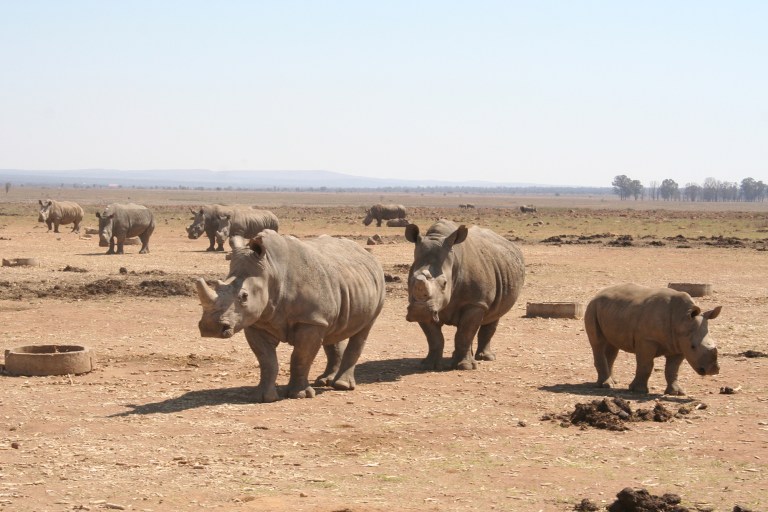
Partially dehorned rhinos at John Hume’s ranch in North West. (Photo: Tony Carnie)
On whether he thought a buyer might appear to rescue Hume’s breeding project, Hughes said: “I honestly don’t know… It might be picked up by someone in Europe or the USA… someone like Elon Musk, possibly.”
The flip side, he suggested, was that Hume could be forced to sell off his rhinos cheaply to defray expenses – or be compelled to “surrender” them as part of a government scheme.
He said that while it had become fashionable for animal rights group to oppose the hunting or sale of wildlife, the private sector had made “a fantastic contribution to rhino conservation”, notably in South Africa, Kenya and Namibia.
Our Burning Planet’s initial attempts to contact Hume directly for comment and clarification about the auction did not succeed.
However, in response to written queries on 13 February, Hume responded by email to confirm that he planned to sell “the entire Southern White Rhino conservation project, including other wildlife (300) & domestic livestock, security infrastructure and assets”.
“Auctioning the project is to bring attention to the opportunity for a new owner to take over the success of the project saving the species from extinction & its potential to rewild…
“I am proudly 81! There are many views of what conservation means. I have bred rhinos for 30 years. I know these rhinos, their habits, their social structures, and I am pleased with my contribution to conserving the species. My wish is to hand over this responsibility to a new custodian as dedicated and visionary as I have been.”
Further information about the auction would be disclosed closer to the event on the website below: https://platinumrhino.co.za/auction/
What about his significant stockpile of rhino horns harvested from live rhinos and natural deaths over the last 30 years? Is he also selling that?
“No,” he stated.
But there was one question he dodged, or overlooked:
Was his decision to sell the business a final acknowledgement that the lifting of the CITES ban on rhino horn sales was unlikely to occur in his lifetime?
The answer to that question can, perhaps, be found in an article published in 2018 by the Save the Rhino charity group:
“We have considered options available to Mr Hume and, unless a new buyer for Buffalo Dreams Ranch and its rhinos in entirety can be found, believe it will be necessary to pursue a combination of strategies to safeguard the 1,626 Southern white rhinos.
“John Hume is clearly a passionate individual who cares for his rhinos. However, his business model has always been premised on a legalised trade in rhino horn, without – seemingly – a contingency plan for what might happen to these rhinos if the trade ban continued. The lack of a back-up plan has, unfortunately, brought us to today’s situation.
“While we cannot fund a rescue plan, we sincerely hope that the outcome, which may be a combination of options, is truly in the rhinos’ best interests and for genuine rhino conservation reasons.” DM/OBP

Some of John Hume’s nearly 2,000 strong herd of semi-wild rhinos are fed with supplemental feeds during the dry winter months at his 8,500 hectare ranch in North West. (Photo: Tony Carnie)
By Tony Carnie | 14 Feb 2023
Thirty years after embarking on a speculative – and controversial – wildlife industry venture, the owner of the world’s biggest privately owned herd of rhinos has announced plans to sell up.
___________________________________________________________________________________________________________________________
The South African rhino baron John Hume, now aged 81, issued a media statement this week inviting investors to purchase his “Platinum Rhino breeding and conservation project” (and all 2,000 rhinos) at an online auction to be held in mid-April.
Hume has been cast variously as a “remarkable conservationist” and also as an avaricious speculator who helped to fuel continued global demand for black market rhino horns.
Hume has pushed strongly to overturn the 1977 global ban on rhino horn sales, arguing that there would be no need to kill any rhinos if their horns could be harvested on a regular basis and then sold legally to buyers in the Far East.

Johnny Hennop removes another horn for stockpiling at John Hume’s ranch in North West. (Photo: Supplied)
But with anti-poaching and breeding costs mounting steadily, Hume appears to have taken a business decision to pack up his rhino breeding business for good, hoping that wealthy investors or philanthropists will see some merit in keeping his venture alive – either for similar commercial reasons or to “rewild” them.
Five years ago, Hume invited investors to take up to a 50% interest in his 8,500 hectare rhino breeding ranch in North West – but there were no takers.
In 2019, he put up a separate property (Mauricedale Game Farm near Kruger National Park) for auction to defray his costs, but not a single buyer came forward when the auctioneer opened the bidding.
His previous attempts to sell a small portion of his massive stockpile of rhino horns in an online auction in 2017 also fell pretty flat, as buyers clearly saw little merit in purchasing horns legally in South Africa when they were prevented from selling them on to buyers in China, Vietnam or elsewhere due to an international ban by the Convention on International Trade in Endangered Species (CITES).

Rhino baron John Hume at his rhino ranch, west of Johannesburg. (Photo: Tony Carnie)

John Hume’s wife Albina pitches her message in a Facebook post. (Photo: Supplied)
Though Hume won a significant court battle in 2015 to overturn a government ban on the domestic sale of rhino horns within South Africa, his more recent forays in the courts have been less successful.
In 2021, Hume sought a court order for the return of nearly R10-million worth of horns which had been seized by the police in an undercover operation by the Hawks during an investigation into black market rhino sales by Hume and other parties.
Two men, Clive John Melville and Petrus Steyn, pleaded guilty and were convicted on charges of engaging in restricted wildlife activities without permits – to wit, possession of 181 white rhino horns that originated from Hume’s secure banking vault in Centurion, Pretoria.
Hume denied any legal wrongdoing in the affair and sued to have the horns returned to him, but Acting Judge SK Hassim found it hard to swallow his story that he had released the horns from his banking vault to a certain Mr Allan Rossouw of Port Elizabeth – a man he had never met – as part of a legal domestic rhino horn transaction.
Counsel for the Hawks and a senior police investigating officer told the court that Rossouw never intended to buy the horns and had merely agreed to have the sale permit registered in his name in exchange for cash.
“This and the other strange features of the transaction between (Hume) and Rossouw,” she argued, “show not only a sham transaction to disguise the illegal sale of the 181 horns, but they show (Hume’s) complicity.
“It was submitted that, in the circumstances, the 181 horns should not be returned to (Hume) before he has explained his involvement and his conduct and that the proper forum for this is not a civil court, but the criminal court,” Hassim declared in a judgment in January 2022.
“(Hume’s) version of events strikes me as most bizarre. It is astounding that a self-professed businessman would voluntarily release valuable assets, such as rhino horns, from his control and custody, entrust them to a ‘potential buyer’ he has never personally met for inspection in the hope that the potential buyer becomes a buyer of the 181 horns at a reasonable price to be agreed. It defies logic why the potential buyer could not inspect the horns at the Centurion vault…
“It is implausible that any person, let alone a self-professed businessman, would release from his control and custody not a few, but all 181 horns, each valued at around R60,000, to a potential buyer without any assurance that the potential buyer intended buying one of them, let alone 181. This scenario borders on the preposterous.”
Hume also lost another civil case in 2020 where he took on national Environment Minister Barbara Creecy, in a case where he was refused permission to sell and export 11 rhinos to a Vietnamese buyer.
Now Hume has averred that he wants to pack up his venture for good and look for a buyer “with a passion for conserving rhinos and the means to keep the breeding project going”.
He argues that his venture has the potential to “save rhinos from extinction”.
“With 200 rhinos born a year, the project has the power to make a significant difference and bolster declining rhino populations on the African continent.
“We have so much rewilding power here,” the project’s wildlife veterinarian, Dr Michelle Otto, said in a statement.
“The project’s rhino could repopulate the whole of Africa, where we lose hundreds of rhinos each year to poaching. We have rewilding partners on board, but the project needs funding and it needs the right person to continue to drive it in the right direction.”

A pie-chart depicting the expenses of running the ranch. (Image: Supplied)
That might seem like a tall claim to make, but in the context of the unrelenting massacre of South Africa’s national rhino herd, it’s worth noting that Hume’s project has preserved at least 2,000 rhinos – just slightly fewer than the remaining population of rhinos in Kruger National Park.
Over the last decade, South Africa has lost close to 10,000 rhinos to poachers – mostly in state or provincial parks.
Dr John Hanks, a zoologist with a PhD from Cambridge on elephant population dynamics and a former director of the Africa Programme for WWF International, has provided a strong endorsement for Hume’s Platinum Rhino venture.
“This is an outstanding contribution to the long-term security of the species, for which (Hume) deserves an enormous vote of thanks and appreciation from the international conservation community. This remarkable success could not have been achieved without an unprecedented level of financial support, all of which has come from John’s life savings.
“Protecting rhinos in today’s world from the increasing attacks by poaching gangs is an extremely expensive operation, as all the government conservation agencies in Africa know only too well.”
Dr George Hughes – a veteran conservationist and former chief executive of the Natal Parks Board/Ezemvelo KZN Wildlife, who favours a legal trade in rhino horn – said this week that Hume’s decision to put his rhino breeding enterprise up for auction was likely to be “a great disappointment to both John and to rhino conservation”.
“I know that John was often criticised. But he should have been awarded a Nobel Prize for rhino conservation, whatever his motives. He has looked after a significant portion of the world’s rhino population at his own cost.
“John could be a difficult customer, but the effort he has made to look after his animals is admirable.”

Partially dehorned rhinos at John Hume’s ranch in North West. (Photo: Tony Carnie)
On whether he thought a buyer might appear to rescue Hume’s breeding project, Hughes said: “I honestly don’t know… It might be picked up by someone in Europe or the USA… someone like Elon Musk, possibly.”
The flip side, he suggested, was that Hume could be forced to sell off his rhinos cheaply to defray expenses – or be compelled to “surrender” them as part of a government scheme.
He said that while it had become fashionable for animal rights group to oppose the hunting or sale of wildlife, the private sector had made “a fantastic contribution to rhino conservation”, notably in South Africa, Kenya and Namibia.
Our Burning Planet’s initial attempts to contact Hume directly for comment and clarification about the auction did not succeed.
However, in response to written queries on 13 February, Hume responded by email to confirm that he planned to sell “the entire Southern White Rhino conservation project, including other wildlife (300) & domestic livestock, security infrastructure and assets”.
“Auctioning the project is to bring attention to the opportunity for a new owner to take over the success of the project saving the species from extinction & its potential to rewild…
“I am proudly 81! There are many views of what conservation means. I have bred rhinos for 30 years. I know these rhinos, their habits, their social structures, and I am pleased with my contribution to conserving the species. My wish is to hand over this responsibility to a new custodian as dedicated and visionary as I have been.”
Further information about the auction would be disclosed closer to the event on the website below: https://platinumrhino.co.za/auction/
What about his significant stockpile of rhino horns harvested from live rhinos and natural deaths over the last 30 years? Is he also selling that?
“No,” he stated.
But there was one question he dodged, or overlooked:
Was his decision to sell the business a final acknowledgement that the lifting of the CITES ban on rhino horn sales was unlikely to occur in his lifetime?
The answer to that question can, perhaps, be found in an article published in 2018 by the Save the Rhino charity group:
“We have considered options available to Mr Hume and, unless a new buyer for Buffalo Dreams Ranch and its rhinos in entirety can be found, believe it will be necessary to pursue a combination of strategies to safeguard the 1,626 Southern white rhinos.
“John Hume is clearly a passionate individual who cares for his rhinos. However, his business model has always been premised on a legalised trade in rhino horn, without – seemingly – a contingency plan for what might happen to these rhinos if the trade ban continued. The lack of a back-up plan has, unfortunately, brought us to today’s situation.
“While we cannot fund a rescue plan, we sincerely hope that the outcome, which may be a combination of options, is truly in the rhinos’ best interests and for genuine rhino conservation reasons.” DM/OBP
"Education is the most powerful weapon which you can use to change the world." Nelson Mandela
The desire for equality must never exceed the demands of knowledge
The desire for equality must never exceed the demands of knowledge
- Lisbeth
- Site Admin
- Posts: 67556
- Joined: Sat May 19, 2012 12:31 pm
- Country: Switzerland
- Location: Lugano
- Contact:
Re: Saving Private Rhino: We must reimagine the future of species conservation in South Africa
I wonder how he has managed to survive economically  Rhinos cannot be his only area of business
Rhinos cannot be his only area of business 
"Education is the most powerful weapon which you can use to change the world." Nelson Mandela
The desire for equality must never exceed the demands of knowledge
The desire for equality must never exceed the demands of knowledge
- Richprins
- Committee Member
- Posts: 76086
- Joined: Sat May 19, 2012 3:52 pm
- Location: NELSPRUIT
- Contact:
Re: Saving Private Rhino: We must reimagine the future of species conservation in South Africa
What a legend! 
Please check Needs Attention pre-booking: https://africawild-forum.com/viewtopic.php?f=322&t=596
- Lisbeth
- Site Admin
- Posts: 67556
- Joined: Sat May 19, 2012 12:31 pm
- Country: Switzerland
- Location: Lugano
- Contact:
Re: Saving Private Rhino: We must reimagine the future of species conservation in South Africa
Immagine if the rhino horn trade had been allowed 
"Education is the most powerful weapon which you can use to change the world." Nelson Mandela
The desire for equality must never exceed the demands of knowledge
The desire for equality must never exceed the demands of knowledge
- Lisbeth
- Site Admin
- Posts: 67556
- Joined: Sat May 19, 2012 12:31 pm
- Country: Switzerland
- Location: Lugano
- Contact:
Re: Saving Private Rhino: We must reimagine the future of species conservation in South Africa

"Education is the most powerful weapon which you can use to change the world." Nelson Mandela
The desire for equality must never exceed the demands of knowledge
The desire for equality must never exceed the demands of knowledge
- Lisbeth
- Site Admin
- Posts: 67556
- Joined: Sat May 19, 2012 12:31 pm
- Country: Switzerland
- Location: Lugano
- Contact:
Re: Saving Private Rhino: We must reimagine the future of species conservation in South Africa
With 2,000 rhinos up for sale but few takers, it’s time for an urgent rethink
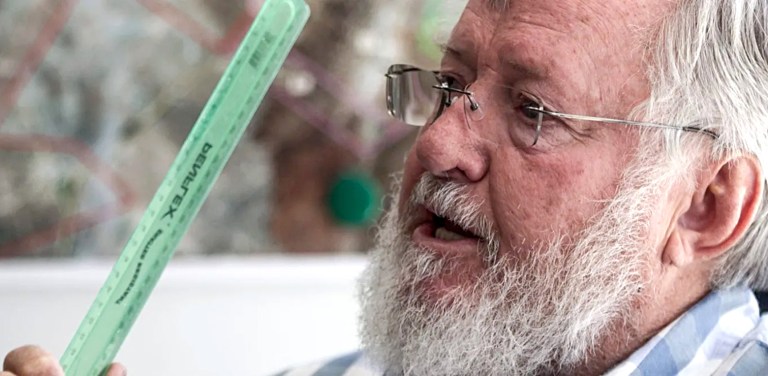
Rhino breeder John Hume. (Photo: Gallo Images / Rapport / Conrad Bornman)
By Helena Kriel | 16 Apr 2023
Is rhino breeder John Hume a reviled, money-grubbing entrepreneur or revered conservation hero? Either way, the forthcoming auction of his farm and 2,000 rhinos is a conservation crisis. But might it be an opportunity for a major repopulation of the country’s declining rhinos?
___________________________________________________________________________________________________________________________
Meet John Hume. He’s 81, emotional and running out of money. And he’s about to auction off the 2,000 rhinos he’s been looking after for 30 years. The rhinos living on an 8,500 square hectare property are under tight anti-poaching surveillance. This is because their horns, even though trimmed, fetch $100,000 a kilo on the black market.
Read more in Daily Maverick: John Hume’s white rhino breeding project to go on auction in mid-April
I drive through with a colleague to meet Hume. The auction is approaching and there is grave concern: who’s going to buy the rhinos? Who might take ownership of what is potentially the most genetically diverse southern white rhinos in existence today (their founding population was sourced from 98 different geographic locations)?
And who will pay the scary price of R180,000 a day for their care and protection? Only a handful have registered for the online auction so far, which begins on 26 April. As the day looms ever closer, the dialogue around it becomes more despairing.
“What are you going to do if no one shows up?” I ask later, as we sit in his office. “Or if no one meets your starting price of $10,000,000 for the rhinos and the property?”
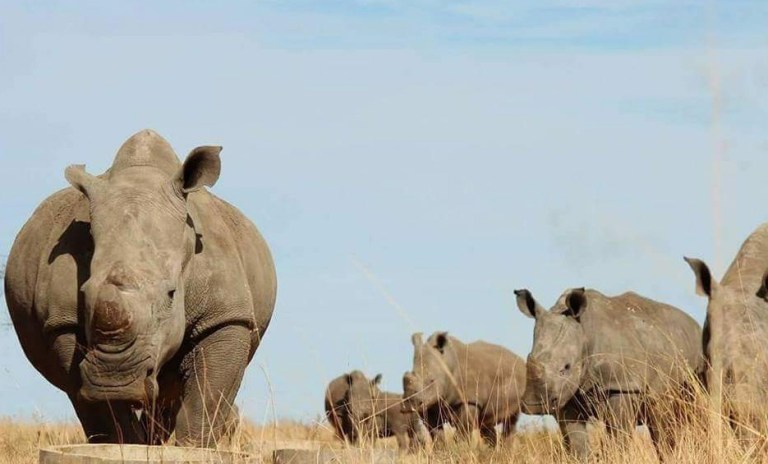
Hume Youngsters. (Photo:Adele C Smith)
“Sell them off for R20,000 or R30,000 a rhino,” he answers, and his bloodshot eyes tear. This is tantamount to giving them away, these sleek and healthy creatures. It means hunters will come for them, or those who want to make a quick profit.
Read more in Daily Maverick: Quo vadis South Africa’s rhino rancher supreme?
On arrival, the road to his property is gouged out; deep grooves require concentration. There’s no sign announcing him, no street numbers. We stop at a ramshackle house with a statue of a rhino in the garden.
“This has to be it,” I say.
He comes out to meet us. “My name is John,” he says. He’s wearing rumpled clothes that could be pajamas. We follow him along a path to the house. Peacocks scratch in the dirt and long-legged golden orb spiders sit in gigantic webs that span the area.
The office has three large desks all cluttered with files. His value system is on display: family photos and rhino. There are beaded rhinos, sculpted rhinos and photographs of rhinos standing in high grass. There are dogs too, three pampered Jack Russels chew on meaty bones, making a mess.
Rhinos are poaching underdogs
“Why rhinos?” I ask.
“It’s the bane of my life. I’m sympathetic and emotional. Rhinos are underdogs. They stand the least chance of surviving poaching,” he says. “It’s impossible to say what these 2,000 rhinos have cost me. Billions. I was rich then. And now I’m not.” He tears up again.
It’s hot out there. Sun filters in through blinds drawn against late summer heat. Hume shifts around in a chair, the leather worn and peeling back. He speaks easily, answering any question put to him. I saw him at the CITES conference in 2017. He seemed strong then, arrogant even, but he’s fragile now.
“I never wanted a fortune,” he says. “But I wanted the rhinos to pay for themselves. This is how the world works. You get paid for breeding something successfully: dogs, vegetables, race horses, but you’re not allowed to have rhinos generate money for you.”
His assistant brings in breakfast. He offers to share the yoghurt, jellied meat, avocados and cut-up fruit. We decline.
“There are a hundred examples of how animals have thrived when they have a value,” he says, eating the yogurt with more relish than he eats the meat. “When it became legal for landowners to own wild animals, there were three million wild animals. Now there are 22 million on privately owned land. Why? Because it was profitable to keep them.”
South African-born, Hume tried and failed at farming, so he bought three hotels, which generated a reasonable income. He established himself in the holiday resort business, which panned out nicely, and he had the cash to buy a game ranch. He started with buffaloes, and then bought five black and five white rhinos.
I am trying to get the measure of the man: this person who has so polarised the rhino world. His emotion intrigues me: he tears up often and without restraint.
“Eight-one was a difficult birthday,” he says. “I’ve got a sore back and I’m against the wall now, with no income. I have five heirs and I cannot leave them with nothing, I will be a broken man. I could still live for a few years and I don’t want to be poor. I want to retire, but I need money to do that.”
I walk through the house: it’s barebones. Spare bedrooms have beds with bare mattresses. No carpets on floors. There is minimal comfort here. His wife enters briefly, 35 years younger than him, friendly and attractive, her attire basic. She doesn’t look like the wife of a wealthy man.
Genetically diverse rhinos
On this property there are 2,000 genetically diverse rhinos. Every year between 140 and 200 calves are born, enough rhinos to repopulate depleted rhino numbers across the country and even, in time, beyond South Africa. I ask how he feels about rhinos now, the creature that has shaped his destiny.
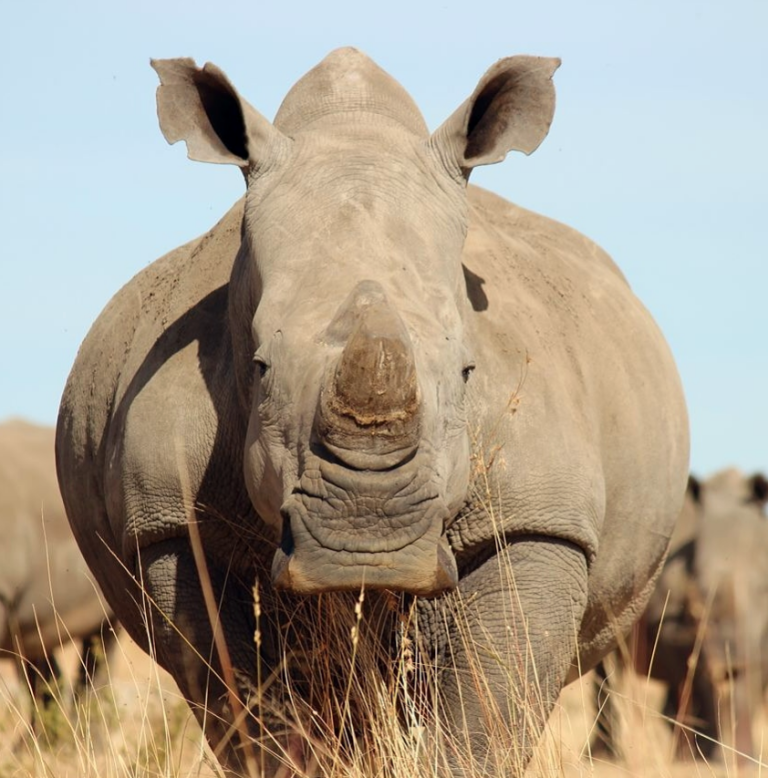
Very pregnant. Photo: Justine Gartrell.
“I still love rhinos,” he says. “They’re friendly. They want to make it work.”
Brandon Jones, head of his security, takes us to see the ops room. It’s from here that the rhinos are protected. All the guys are in camo. They’re fit and young and living at the end of a very rutted road, an hour’s drive from the closest town, which consists of a Wimpy, a Spar, a post office and then veld. I try to understand their choices. Why here? So far from it all?
A “risk technician” sits in front of a wide bank of monitors. His eyes don’t leave the screens, no cellphone for him to check his social media for some relief.
“Twelve hours watching screens?” I ask.
“You get used to it,” he says. “You build up to it and eventually you’re working the full hours without stress or burnout.” The combination of everything the security team do is working. They can attest to no poaching since 2017.
We head to the rhino orphanage. In the wild, 5% of baby rhinos die, but here every rhino counts. Thirty young rhinos of differing ages, sizes and temperaments are being fed because it’s milk time. Claudia Andrione, who has overseen the orphanage for 11 years, is keeping a watchful eye on the milk mixing.
“It’s not just because you love the animals,” she says. “No one loves a baby rhino at 3am! It’s a calling.” We wander between the enclosures where volunteers are feeding calves milk from buckets. All the rhinos are paired up and happily suck on the milk teats, side by side. “Newborns are easy,” she says. “Two-month-olds try to kill you! But it’s very rewarding. I got a little one in winter, basically frozen, no temperature, no glucose reading. Eight hours later he started coming alive again.”
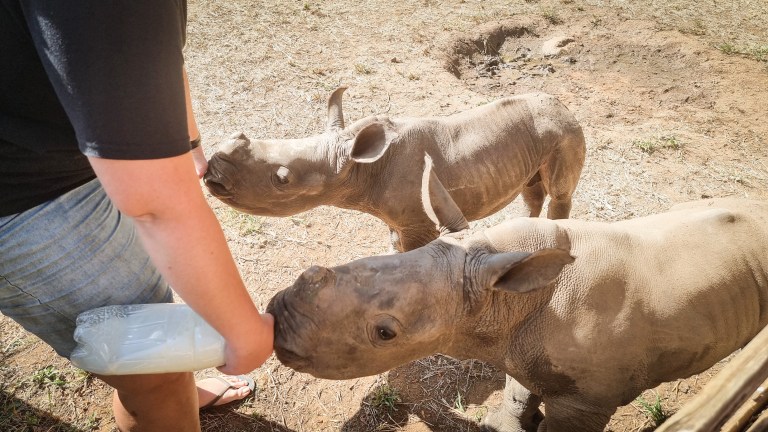
Milk time at the Hume orphanage. (Photo:Karina Suter)
The 180 babies saved
There are many stories of the 180 babies saved through the years in this bustling orphanage.
“I had a calf who survived a caesarean birth when the mother died. He lay in my kitchen for two days. And now he’s a healthy bull of eight years.”
I steer the conversation towards John Hume. “He’s a conservationist,” Andrione says. “These beautiful rhinos wouldn’t exist without him.”
We’re handed over to Ryna Lategan, a security manager. He’s newly married and shows us a photo of his wife. She’s an attractive Indian woman, a very long way from India. So, how are they managing an hour from the nearest one-horse town?
“You can’t compare this to any other project,” Lategan says. “It’s a privilege to work here. You have to be on your game. There’s nowhere else in the world like this. These 2,000 rhinos will save the species.”
Save the species? A powerful thought.
We drive through one of the vast rhino camps. Hume’s rhinos are scattered across bush reclaimed from what was once cattle and crop farming. The grass grows high and the rhinos graze peacefully. We drive for sometimes 20 minutes between little crashes, the horizon is wide.
So, how did this whole thing happen?
I speak to Dr Michelle Otto, Hume’s resident wildlife vet. “He wanted to retire in 1993 and he bought a property to retire onto. His small rhino crash expanded to 200 and he realised he loved them.”
Desperate anti-poacher owners
In 2007 poaching started and owners of rhinos became desperate. “Buy our rhino! Take them!” Rhinos arrived from all over the country – 98 different geographical locations – until Hume had to register as a captive breeding operator, the first in South Africa.
“He didn’t buy 2,000 rhinos,” Otto says. “It was the necessity of people in despair.”
As the numbers grew, he had to buy more land, farms that he transformed into bushveld. He separated his rhinos into different populations, further diversifying to guard against inbreeding. A stud book became a record of just exactly who the mother and father were to a little calf and what the genetics were, keeping all the records in place, all accuracy checked.
“The way it works is this: for every 20 cows there is one alpha bull and four to six young males, making up a sub-population of bulls. The females choose the bull,” she explains. “There will always be genetically diverse sub-adult bulls in a population. There’s no problem of running out of genetics in the sub-populations because they come from different regions and as such have different gene pools.
“Rhinos have a 10-year generation link,” Otto says. “It takes eight years for a rhino to become of breeding age and almost another two to gestate. So, it’s 10 years before the bull who sired a female calf would have access to that female calf. When she’s of breeding age, she’s removed from that enclosure and placed with other bulls.”
Successfully reproduce
Because it takes a young male 10 years to be ready to mate and Hume has had his rhinos for only 18 years, the second generational link is just starting now. So, there’s no possibility of inbreeding.
Hume’s rhinos reproduce successfully with 140 to 200 calves born a year. This is a significant contribution of genetically diverse rhinos being born into a dwindling rhino population, one veering ever closer to extinction because of poaching and SANPark’s failure to protect them.
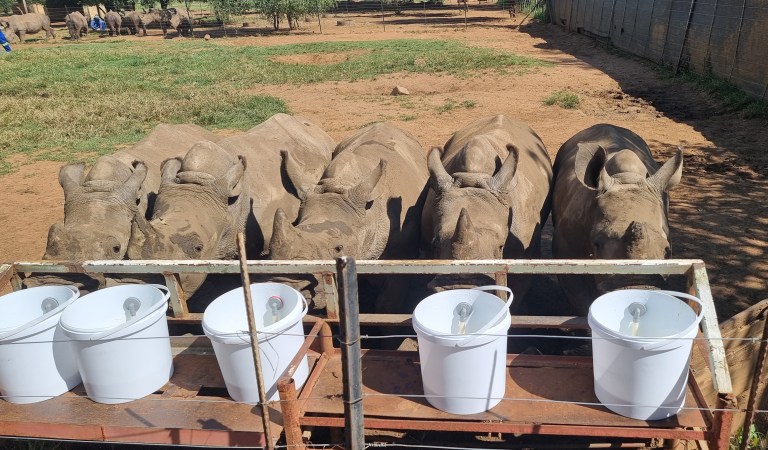
Babies and Bottles.(Photo:Karina Suter)
A common judgement made of Hume’s rhinos is that they’re domesticated and will not survive in the wild, something Hume shrugs off with irritation. “Get out of your car near one of the rhinos,” he says. “They’re wild, they’ll run.”
Otto explains this in more detail. “We don’t interfere with them, the cows raise their calves and choose their mates, there’s no selection we make for them and no artificial insemination. Because we have small predators here, the mothers teach their babies how to survive. They grow up with all their natural instincts intact.”
She says the location is home to 200 species of birds and around 100 different mammals, from meerkats to black-footed cats, an endangered animal now breeding successfully there. Endemic trees have replaced crop and cattle land. The rhinos have effectively brought back the bushveld.
I’m going along with all of this. Everyone is committed and loyal to Hume, they speak about him with respect, even love. But what of the criticism: aren’t Hume’s rhinos bred in captivity? Don’t they eat from feedlots? We’ve all seen the pictures of rhinos clustered around feeding troughs. Otto gives a resounding no.
“It’s only during the cold winter months from May to August that the rhinos get supplemental food, this is the same grasses they’ve been eating all summer, baled and dried for their winter feed. But it’s never more than half their daily intake. The rest of the time the rhinos wander in their large areas and graze just as wild rhinos would do.
Captive vs sustainable breeding debate
But they’re captive nonetheless! Or aren’t they?
“What is captive breeding?” she asks me. “What is sustainable breeding? It’s an insurance policy. It allows the animals to breed in safety with the ultimate plan being to re-establish them back into the wild. As rhino numbers dwindle at a terrifying pace, as they lose their genetics, this project can provide South Africa and the world with rhinos that are healthy, with strong genetic footprints.
“The problem is the project hasn’t been sustainable,” she adds. “The rhino would need to be sold on auction at a decent price to bring money back into the project.” The possibility of horn sale is not on the table, and not a subject we debate.
“So what if John wants to make money from his rhinos? If he invests in it, shouldn’t he make money?” she asks. “Don’t the NGOs make money with all their campaigns? Their demand reduction campaigns and their campaigns around orphans? With rhino owners, all their money goes back into it, so shouldn’t they have some remuneration? One has to work with wildlife in such a way that there is the necessary capital return. If you generate an income, the animal pays for its own conservation going into the future.”
She speaks fast and with urgency, as though she is running out of time. “NGOs and government make the decisions, but they have no experience in the veld! Our voices aren’t heard. Rhino custodians have no voice in this.”
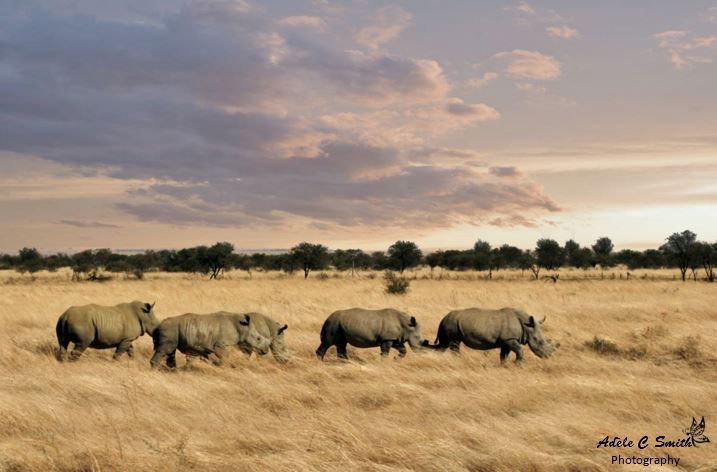
Hume crash Photo: Adele C Smith
This seems absurd. How can the people who live and work with their rhinos have no say in this? How do the rhino owners, who are effectively saving the species, go unheard? And why is it that the NGOs and government control the narrative and the rules around rhinos?
We lapse into silence, then I ask:
Are you concerned about the upcoming auction?”
“I’m concerned that the wrong parties will come forward. People who aren’t concerned about the rhinos. We love these rhinos.”
Future in the balance
As Lategan drives us back to the car, I look at the rhinos grazing peacefully side by side, benign, curvy, sleek and full of sweetness. Do they know their entire future lies in the balance?
I’m perturbed as we drive back to Johannesburg on an endless-seeming national road. The traffic is hard and fast, so many cars getting so many humans home. And I think: so few rhinos. And here we are with 2,000 magnificent, genetically diverse rhinos. Isn’t this a conservation triumph?
Regardless of how one might feel about John Hume, why isn’t this treasure trove of rhinos being considered as vital to their preservation? Where are the conservationists? Where are the NGOs? The auction starts on 26 April and there’s an eerie silence about it. Are we, who care for rhinos, going to stand by and watch them being auctioned off for the lowest price? Will it matter that they go to hunting concessions? Magnificent, genetically diverse rhinos – 2,000 of them? That would be a conservation apocalypse.
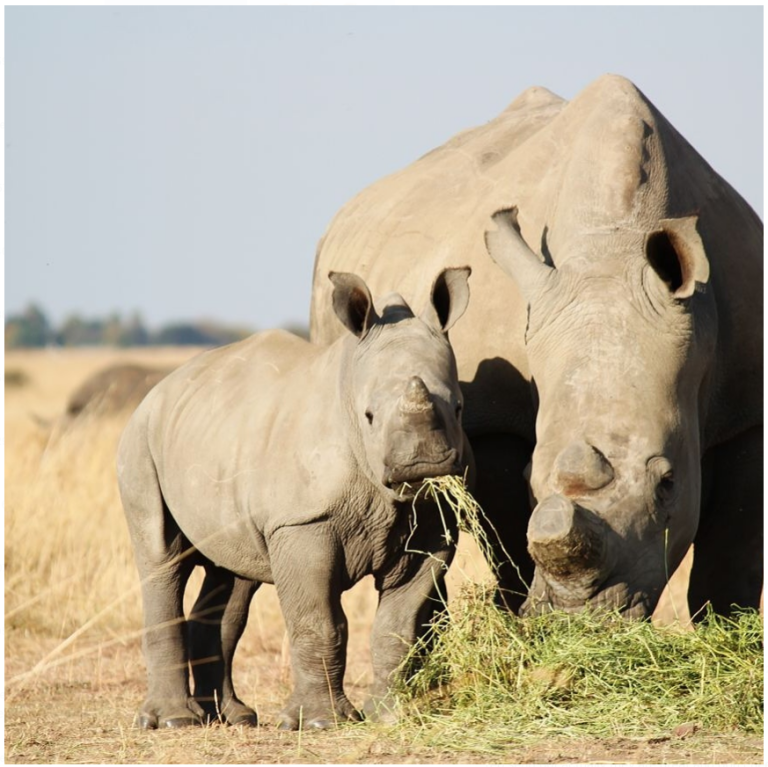
Winter supplemental feed: Photo: Justine Gartrell.
And I think: why is the divisive culture around John Hume the dominating factor? We have a chance for a major repopulation of the country’s declining rhinos. This is an opportunity beyond measure. Or is everyone so caught up in fractious rhino debate that we’ve lost sight of what’s possible here? DM/OBP
Helena Kriel is a scriptwriter and author. She is the founder of NGO Baby Rhino Rescue.

Rhino breeder John Hume. (Photo: Gallo Images / Rapport / Conrad Bornman)
By Helena Kriel | 16 Apr 2023
Is rhino breeder John Hume a reviled, money-grubbing entrepreneur or revered conservation hero? Either way, the forthcoming auction of his farm and 2,000 rhinos is a conservation crisis. But might it be an opportunity for a major repopulation of the country’s declining rhinos?
___________________________________________________________________________________________________________________________
Meet John Hume. He’s 81, emotional and running out of money. And he’s about to auction off the 2,000 rhinos he’s been looking after for 30 years. The rhinos living on an 8,500 square hectare property are under tight anti-poaching surveillance. This is because their horns, even though trimmed, fetch $100,000 a kilo on the black market.
Read more in Daily Maverick: John Hume’s white rhino breeding project to go on auction in mid-April
I drive through with a colleague to meet Hume. The auction is approaching and there is grave concern: who’s going to buy the rhinos? Who might take ownership of what is potentially the most genetically diverse southern white rhinos in existence today (their founding population was sourced from 98 different geographic locations)?
And who will pay the scary price of R180,000 a day for their care and protection? Only a handful have registered for the online auction so far, which begins on 26 April. As the day looms ever closer, the dialogue around it becomes more despairing.
“What are you going to do if no one shows up?” I ask later, as we sit in his office. “Or if no one meets your starting price of $10,000,000 for the rhinos and the property?”

Hume Youngsters. (Photo:Adele C Smith)
“Sell them off for R20,000 or R30,000 a rhino,” he answers, and his bloodshot eyes tear. This is tantamount to giving them away, these sleek and healthy creatures. It means hunters will come for them, or those who want to make a quick profit.
Read more in Daily Maverick: Quo vadis South Africa’s rhino rancher supreme?
On arrival, the road to his property is gouged out; deep grooves require concentration. There’s no sign announcing him, no street numbers. We stop at a ramshackle house with a statue of a rhino in the garden.
“This has to be it,” I say.
He comes out to meet us. “My name is John,” he says. He’s wearing rumpled clothes that could be pajamas. We follow him along a path to the house. Peacocks scratch in the dirt and long-legged golden orb spiders sit in gigantic webs that span the area.
The office has three large desks all cluttered with files. His value system is on display: family photos and rhino. There are beaded rhinos, sculpted rhinos and photographs of rhinos standing in high grass. There are dogs too, three pampered Jack Russels chew on meaty bones, making a mess.
Rhinos are poaching underdogs
“Why rhinos?” I ask.
“It’s the bane of my life. I’m sympathetic and emotional. Rhinos are underdogs. They stand the least chance of surviving poaching,” he says. “It’s impossible to say what these 2,000 rhinos have cost me. Billions. I was rich then. And now I’m not.” He tears up again.
It’s hot out there. Sun filters in through blinds drawn against late summer heat. Hume shifts around in a chair, the leather worn and peeling back. He speaks easily, answering any question put to him. I saw him at the CITES conference in 2017. He seemed strong then, arrogant even, but he’s fragile now.
“I never wanted a fortune,” he says. “But I wanted the rhinos to pay for themselves. This is how the world works. You get paid for breeding something successfully: dogs, vegetables, race horses, but you’re not allowed to have rhinos generate money for you.”
His assistant brings in breakfast. He offers to share the yoghurt, jellied meat, avocados and cut-up fruit. We decline.
“There are a hundred examples of how animals have thrived when they have a value,” he says, eating the yogurt with more relish than he eats the meat. “When it became legal for landowners to own wild animals, there were three million wild animals. Now there are 22 million on privately owned land. Why? Because it was profitable to keep them.”
South African-born, Hume tried and failed at farming, so he bought three hotels, which generated a reasonable income. He established himself in the holiday resort business, which panned out nicely, and he had the cash to buy a game ranch. He started with buffaloes, and then bought five black and five white rhinos.
I am trying to get the measure of the man: this person who has so polarised the rhino world. His emotion intrigues me: he tears up often and without restraint.
“Eight-one was a difficult birthday,” he says. “I’ve got a sore back and I’m against the wall now, with no income. I have five heirs and I cannot leave them with nothing, I will be a broken man. I could still live for a few years and I don’t want to be poor. I want to retire, but I need money to do that.”
I walk through the house: it’s barebones. Spare bedrooms have beds with bare mattresses. No carpets on floors. There is minimal comfort here. His wife enters briefly, 35 years younger than him, friendly and attractive, her attire basic. She doesn’t look like the wife of a wealthy man.
Genetically diverse rhinos
On this property there are 2,000 genetically diverse rhinos. Every year between 140 and 200 calves are born, enough rhinos to repopulate depleted rhino numbers across the country and even, in time, beyond South Africa. I ask how he feels about rhinos now, the creature that has shaped his destiny.

Very pregnant. Photo: Justine Gartrell.
“I still love rhinos,” he says. “They’re friendly. They want to make it work.”
Brandon Jones, head of his security, takes us to see the ops room. It’s from here that the rhinos are protected. All the guys are in camo. They’re fit and young and living at the end of a very rutted road, an hour’s drive from the closest town, which consists of a Wimpy, a Spar, a post office and then veld. I try to understand their choices. Why here? So far from it all?
A “risk technician” sits in front of a wide bank of monitors. His eyes don’t leave the screens, no cellphone for him to check his social media for some relief.
“Twelve hours watching screens?” I ask.
“You get used to it,” he says. “You build up to it and eventually you’re working the full hours without stress or burnout.” The combination of everything the security team do is working. They can attest to no poaching since 2017.
We head to the rhino orphanage. In the wild, 5% of baby rhinos die, but here every rhino counts. Thirty young rhinos of differing ages, sizes and temperaments are being fed because it’s milk time. Claudia Andrione, who has overseen the orphanage for 11 years, is keeping a watchful eye on the milk mixing.
“It’s not just because you love the animals,” she says. “No one loves a baby rhino at 3am! It’s a calling.” We wander between the enclosures where volunteers are feeding calves milk from buckets. All the rhinos are paired up and happily suck on the milk teats, side by side. “Newborns are easy,” she says. “Two-month-olds try to kill you! But it’s very rewarding. I got a little one in winter, basically frozen, no temperature, no glucose reading. Eight hours later he started coming alive again.”

Milk time at the Hume orphanage. (Photo:Karina Suter)
The 180 babies saved
There are many stories of the 180 babies saved through the years in this bustling orphanage.
“I had a calf who survived a caesarean birth when the mother died. He lay in my kitchen for two days. And now he’s a healthy bull of eight years.”
I steer the conversation towards John Hume. “He’s a conservationist,” Andrione says. “These beautiful rhinos wouldn’t exist without him.”
We’re handed over to Ryna Lategan, a security manager. He’s newly married and shows us a photo of his wife. She’s an attractive Indian woman, a very long way from India. So, how are they managing an hour from the nearest one-horse town?
“You can’t compare this to any other project,” Lategan says. “It’s a privilege to work here. You have to be on your game. There’s nowhere else in the world like this. These 2,000 rhinos will save the species.”
Save the species? A powerful thought.
We drive through one of the vast rhino camps. Hume’s rhinos are scattered across bush reclaimed from what was once cattle and crop farming. The grass grows high and the rhinos graze peacefully. We drive for sometimes 20 minutes between little crashes, the horizon is wide.
So, how did this whole thing happen?
I speak to Dr Michelle Otto, Hume’s resident wildlife vet. “He wanted to retire in 1993 and he bought a property to retire onto. His small rhino crash expanded to 200 and he realised he loved them.”
Desperate anti-poacher owners
In 2007 poaching started and owners of rhinos became desperate. “Buy our rhino! Take them!” Rhinos arrived from all over the country – 98 different geographical locations – until Hume had to register as a captive breeding operator, the first in South Africa.
“He didn’t buy 2,000 rhinos,” Otto says. “It was the necessity of people in despair.”
As the numbers grew, he had to buy more land, farms that he transformed into bushveld. He separated his rhinos into different populations, further diversifying to guard against inbreeding. A stud book became a record of just exactly who the mother and father were to a little calf and what the genetics were, keeping all the records in place, all accuracy checked.
“The way it works is this: for every 20 cows there is one alpha bull and four to six young males, making up a sub-population of bulls. The females choose the bull,” she explains. “There will always be genetically diverse sub-adult bulls in a population. There’s no problem of running out of genetics in the sub-populations because they come from different regions and as such have different gene pools.
“Rhinos have a 10-year generation link,” Otto says. “It takes eight years for a rhino to become of breeding age and almost another two to gestate. So, it’s 10 years before the bull who sired a female calf would have access to that female calf. When she’s of breeding age, she’s removed from that enclosure and placed with other bulls.”
Successfully reproduce
Because it takes a young male 10 years to be ready to mate and Hume has had his rhinos for only 18 years, the second generational link is just starting now. So, there’s no possibility of inbreeding.
Hume’s rhinos reproduce successfully with 140 to 200 calves born a year. This is a significant contribution of genetically diverse rhinos being born into a dwindling rhino population, one veering ever closer to extinction because of poaching and SANPark’s failure to protect them.

Babies and Bottles.(Photo:Karina Suter)
A common judgement made of Hume’s rhinos is that they’re domesticated and will not survive in the wild, something Hume shrugs off with irritation. “Get out of your car near one of the rhinos,” he says. “They’re wild, they’ll run.”
Otto explains this in more detail. “We don’t interfere with them, the cows raise their calves and choose their mates, there’s no selection we make for them and no artificial insemination. Because we have small predators here, the mothers teach their babies how to survive. They grow up with all their natural instincts intact.”
She says the location is home to 200 species of birds and around 100 different mammals, from meerkats to black-footed cats, an endangered animal now breeding successfully there. Endemic trees have replaced crop and cattle land. The rhinos have effectively brought back the bushveld.
I’m going along with all of this. Everyone is committed and loyal to Hume, they speak about him with respect, even love. But what of the criticism: aren’t Hume’s rhinos bred in captivity? Don’t they eat from feedlots? We’ve all seen the pictures of rhinos clustered around feeding troughs. Otto gives a resounding no.
“It’s only during the cold winter months from May to August that the rhinos get supplemental food, this is the same grasses they’ve been eating all summer, baled and dried for their winter feed. But it’s never more than half their daily intake. The rest of the time the rhinos wander in their large areas and graze just as wild rhinos would do.
Captive vs sustainable breeding debate
But they’re captive nonetheless! Or aren’t they?
“What is captive breeding?” she asks me. “What is sustainable breeding? It’s an insurance policy. It allows the animals to breed in safety with the ultimate plan being to re-establish them back into the wild. As rhino numbers dwindle at a terrifying pace, as they lose their genetics, this project can provide South Africa and the world with rhinos that are healthy, with strong genetic footprints.
“The problem is the project hasn’t been sustainable,” she adds. “The rhino would need to be sold on auction at a decent price to bring money back into the project.” The possibility of horn sale is not on the table, and not a subject we debate.
“So what if John wants to make money from his rhinos? If he invests in it, shouldn’t he make money?” she asks. “Don’t the NGOs make money with all their campaigns? Their demand reduction campaigns and their campaigns around orphans? With rhino owners, all their money goes back into it, so shouldn’t they have some remuneration? One has to work with wildlife in such a way that there is the necessary capital return. If you generate an income, the animal pays for its own conservation going into the future.”
She speaks fast and with urgency, as though she is running out of time. “NGOs and government make the decisions, but they have no experience in the veld! Our voices aren’t heard. Rhino custodians have no voice in this.”

Hume crash Photo: Adele C Smith
This seems absurd. How can the people who live and work with their rhinos have no say in this? How do the rhino owners, who are effectively saving the species, go unheard? And why is it that the NGOs and government control the narrative and the rules around rhinos?
We lapse into silence, then I ask:
Are you concerned about the upcoming auction?”
“I’m concerned that the wrong parties will come forward. People who aren’t concerned about the rhinos. We love these rhinos.”
Future in the balance
As Lategan drives us back to the car, I look at the rhinos grazing peacefully side by side, benign, curvy, sleek and full of sweetness. Do they know their entire future lies in the balance?
I’m perturbed as we drive back to Johannesburg on an endless-seeming national road. The traffic is hard and fast, so many cars getting so many humans home. And I think: so few rhinos. And here we are with 2,000 magnificent, genetically diverse rhinos. Isn’t this a conservation triumph?
Regardless of how one might feel about John Hume, why isn’t this treasure trove of rhinos being considered as vital to their preservation? Where are the conservationists? Where are the NGOs? The auction starts on 26 April and there’s an eerie silence about it. Are we, who care for rhinos, going to stand by and watch them being auctioned off for the lowest price? Will it matter that they go to hunting concessions? Magnificent, genetically diverse rhinos – 2,000 of them? That would be a conservation apocalypse.

Winter supplemental feed: Photo: Justine Gartrell.
And I think: why is the divisive culture around John Hume the dominating factor? We have a chance for a major repopulation of the country’s declining rhinos. This is an opportunity beyond measure. Or is everyone so caught up in fractious rhino debate that we’ve lost sight of what’s possible here? DM/OBP
Helena Kriel is a scriptwriter and author. She is the founder of NGO Baby Rhino Rescue.
"Education is the most powerful weapon which you can use to change the world." Nelson Mandela
The desire for equality must never exceed the demands of knowledge
The desire for equality must never exceed the demands of knowledge
- Lisbeth
- Site Admin
- Posts: 67556
- Joined: Sat May 19, 2012 12:31 pm
- Country: Switzerland
- Location: Lugano
- Contact:
Re: Saving Private Rhino: We must reimagine the future of species conservation in South Africa
Very instructive!
Why doesn't SANParks buy some and see if they can be introduced into the wild? It would be a useful demonstration.
Why doesn't SANParks buy some and see if they can be introduced into the wild? It would be a useful demonstration.
"Education is the most powerful weapon which you can use to change the world." Nelson Mandela
The desire for equality must never exceed the demands of knowledge
The desire for equality must never exceed the demands of knowledge
- Peter Betts
- Posts: 3084
- Joined: Fri Jun 01, 2012 9:28 am
- Country: RSA
- Contact:
Re: Saving Private Rhino: We must reimagine the future of species conservation in South Africa
They would just be Canon Fodder
- Richprins
- Committee Member
- Posts: 76086
- Joined: Sat May 19, 2012 3:52 pm
- Location: NELSPRUIT
- Contact:
Re: Saving Private Rhino: We must reimagine the future of species conservation in South Africa
It is pretty obvious that Hume is a conservation hero. However that is not in the interests of the anti-trade lobby. 
Please check Needs Attention pre-booking: https://africawild-forum.com/viewtopic.php?f=322&t=596


